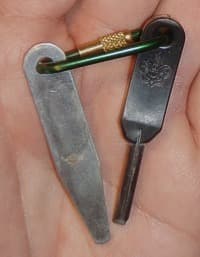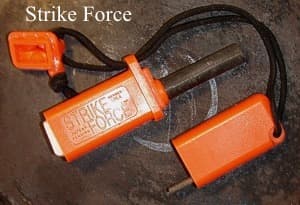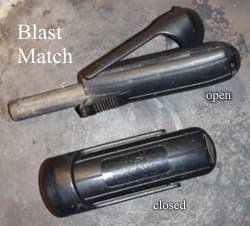Firestarters
The spark has always been at the heart of fire starting - Nature's lightning providing the only access prehistoric man had to the mystical powers of the flame. Their best abilities were to contain the heart of the fire in a glowing ember and hope it would not go out on them. Somewhere along the line of evolutionary Man, a random spark landed on a drop of fat, or cattail fluff or whatever, and ignited.
The evolutionary tree of fire starting spread forth out along the main trunk with four branches. The main trunk would be the flint and steel spark generating method – used for thousands of years and basically the same right up through today (modern materials notwithstanding). The other branches are matches, lighters, friction (as in fire bows, etc.), solar (magnifying glass and the sun) and nature (lightning).
The advantages and disadvantages of each are basic and conditional: Even the most powerful, fool-proof storm match needs a striking strip to light. No strip, no flame. They need to be waterproof, too! Lighters need fuel. No fuel, no flame. No flint, no spark! Rubbing two sticks together or similar requires skill, patients and more skill – not to mention the right materials at hand. Solar is obviously sun dependent – and not being distracted by all the ant targets. Lightning, of course is left pretty much up to chance- and risk.
That leaves flint and steel. Natural flint and steel or another harder, striker rock produce sparks but not necessarily big or powerful ones. Skill and finesse are essential for them to work, too. However, this basic concept of striking a spark producing material with another material to direct sparks onto an ignitable surface has advanced rather effectively into the 21st century.
The "flint" is now usually a section of magnesium that yields a large quantity of high temperature sparks that can be generated by a number of steel strikers – everything from knife blades to glass in some rare cases. Not only has the flint/steel evolved, so too has tinder to the point some starters come with their own little cake of polymer plastic that catch the first spark off the unit and produce a flame about as fast as striking a match.
There are about a half dozen similar but different fire starter units on the market today. The latest designs are small, one-hand-operational units. Flints are chemical composites of metals and mixtures that can produce more and better sparks than just flint or even magnesium alone.
Here's a rundown on the top contenders on the market today:
Generic "Flint & Steel" The basic striker rod and striker blade. It's small, can be worn on a lanyard around the neck and produces an acceptable spark. It is the most basic unit out there. Mine bears the BSA insignia; others are often available as a promotional tool. It's simple, direct. Its main disadvantage is the small size which makes it difficult to use with cold fingers.


The magnesium/striker bars are common fire starters. The one made by Doan has imbedded the striker bar onto the long edge of a magnesium bar. The advantage of this particular fire starter is that you carry the spark catcher (initial tinder) with you in the form of the bar. The idea is to shave off a few flakes of magnesium and then direct your spark into the flakes. It's effective and fast. This does require a hard, rough edge (the back of your knife blade, for example) to generate sparks. These tend to burn very hot. Most come with a hole for attaching a lanyard. Main disadvantage is not having a striker steel with the unit.
Gerber's "Strike Force"
My "Carry Everywhere" fire starter for years while living in Alaska. Its composite spark-generating rod produces a profusion of sparks from a steel-hard tab – both of which are enclosed in a hard plastic case. Pull the case open and the working parts are ready to go with easy-to-hold handles. What's really cool about theStrike Force is that you can carry tinder right in the case. For this article, I pulled out my starter and found a nearly full piece of the soap-like cake used as tinder still in the small compartment in the handle (See photo at right - the white protrusion on the left side is the fuel Cake sticking out of its compartment in the handle). Voila! After being enclosed for over ten years, the tinder still caught a spark and ignited right away!

The unit is about the size of a Snicker™ bar and in my opinion, one of the best fire starters out there for the reasons mentioned.
The BlastMatch™ by Survival Inc. is also my favorite fire starter. Survival Inc. took the basic concept of striker bar and flint and combined the two into a spring plunger design that can be operated by one hand. Pressure is applied to the "flint" by the steel mounted on a flexing handle. The handle is spring mounted so it rides up and down the striker bar. As the user pushes down on the "steel", he/she also pushes down on the end of the striker unit that causes the steel to apply friction to the flint bar as it slides down the rod. Hold the rod tip down onto your tinder and the sparks are cast right at the base of the flint rod. It's a simple, one-handed operation.

I have lit countless fires with this unit. I carry one in my photo kit, in a chest pocket in my jacket and at various other locations within my gear. It's effective at starting dried grasses, crushed dried leaves, birch bark, - a plethora of natural and man-made tinder.
The Sparkie™Fire Starter – is like the kid brother of the BlastMatch. Made by Ultimate Survival Technologies, the Sparkie is basically a small flint rod with a flint, spring-tension tab that utilizes the plunger technique of generating a spark. Holding the body of the small casing and depressing the flint rod down into the casing causes a steel tab to create friction across the flint bar. Same basic principles apply. This unit is quite small and enables the user to start a fire with just one hand.

Aurora Fire Starter by Solo Scientific It makes the most durable fire-starting unit due to its aluminum tube housing. The cross-hatching on the cylinder assures a firm grip. The principles are the same. A composite flint bar attached to the protected, screw-off cap is struck by a hardened piece of steel screwed onto the bottom of the cylinder. A depression at one end of the steel enables the user to make contact with the flint rod at a 45-degree angle. Pressing the top corner edge of the striker tab down along the flint produces bright, hot sparks.
While this produced seemingly hot sparks, more than adequate to start a fire, I found it to be the hardest of the units to generate sparks in the first place. The angle and force must be precise (at least in the unit I tried) to generate any spark at all. The Aurora fire starter has an adjustable rod for when one side becomes worn, a handy feature. A rubber "O" ring closure helps seal out moisture. Currently the kit is being sold with a couple of balls of cotton for convenient tinder support.
Just as this article was being "put to bed" I learned of yet another fire starter – the AMK Spark Lite. Billed as the "aviator’s fire starter" the Spark Lite appears to be a striker wheel on a short handle, rotated by the thumb to generate sparks – kind of what a "lighter" does, eh? It comes with short, stout wicks that serve as spark catchers for presumably easy igniting.
A word on tinder cakes/cubes Several fire starters provide their own packet of tinder. These are cakes or cubes of a soap like polymer plastic that easily chips or flakes off to provide a highly ignitable bed for even just one spark to fuse. The material is non-toxic and can burn while floating on water. It can last almost forever if kept in an airtight container. Placing a few flakes within a natural tinder will help that tinder light quicker and conserve your fuel cake/cube for quite a while.
Strike Force had its own brand at one time, under the Gerber label. UST (Ultimate Survival Tool) offers their fire starting tinder as WetFire™. Other generic brands are probably available, too. When buying these in quantity (usually a dozen per package) make sure you re-seal the pouch after use to keep them "active" for literally years! You may also want to consider making your own (see the "Egg Carton Fire Starter" article).
Here's a fire-starting tip. My style of fire starting is to build up whatever shape of fire I need (teepee, pyramid, etc) with my first round of firewood and kindling. I leave a space at the bottom center of the firewood pile that is accessible from one side. I pile in a significant amount of tinder into the center of the fire structure. I crumble or shave some of the fire starter cube onto a flat rock or chip of bark and ignite it with a spark from the fire starter. As soon as the flame appears steady, I slide the fire, platform and all, into the center of the fire. It lights quickly and efficiently.
SURVIVAL TIP:
A side benefit of a fire starter that can produce a large field of sparks is that of a signaling device. A solid swipe down the length of a striker strip can produce several seconds of camera-flash bright light capable of being seen at a great distance. It could be used as a means of signaling in the right conditions. Even those that need a surface to exert pressure against to produce friction could be used with a pan lid or similar to produce a reflective flash. Not perfect, but there is that multiple use component to consider.
As with any new product, don't wait until you need to call upon it in the wild – give it a try at home or during a casual weekend camping trip. A dual lesson would be to gather a variety of tinder and experiment with which one work best at converting that spark into a quick, lasting flame. You'd be surprised at what does and doesn't work.
You can find these fire starters at most outdoor retail stores, ranging in price from about $10 to $35. Most pocket survivor kits will contain a basic flint and steel unit. Carry it and a whistle around your neck and you have a versatile and vital survival kit right there, ready to go!
Have fun and be safe out there!
Tom Watson is an avid sea kayaker and freelance writer.
His latest book, "Kids Gone Paddlin" is available on Amazon.com.
He is also the author of "How to Think Like A Survivor"
Related Articles
This question is from imsealin – they asked how long should a kayak be for sea kayaking, and can it be…
One of the considerations for deciding which type of material you want your kayak to be made from…
I've been busy lately rearranging my cooking essentials: the little tools that I can't do without. Of…
In 1971, I outfitted and guided three wealthy Chicago men--the least affluent of which earned a quarter…



